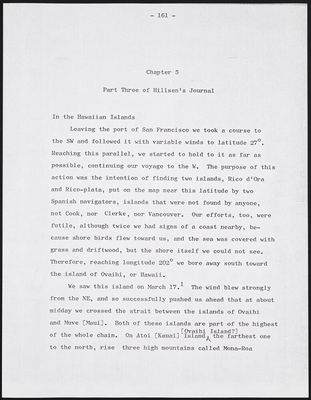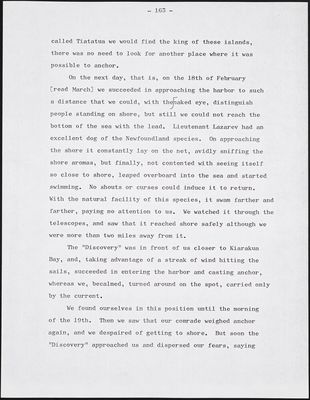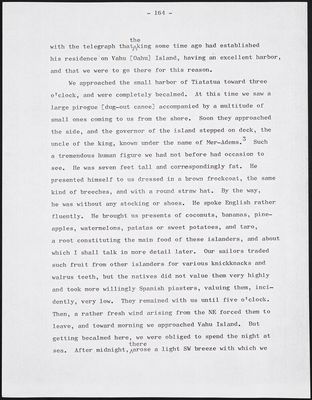Pages
mss142-vasilevShishmarev-i5-001
-161-
Chapter 5 Part Three of Hillsen's Journal
In the Hawaiian Islands
Leaving the port of San Francisco we took a course to the SW and followed it with variable winds to latitude 27. Reaching this parallel, we started to hold to it as far as possible, continuing our voyage to the W. The purpose of this action was the intention of finding two islands, Rico d'Ora and Rico-plata, put on the map near this latitude by two Spanish navigators, islands that were not found by anyone, not Cook, nor Clerke, no Vancouver. Our efforts, too, were futile, although twice we had signs of a coast nearby, because shore birds flew toward us, and the sea was covered with grass and driftwood, but the shore itself we could not see. Therefore, reching longitude 202 we bore away south toward the island of Ovaihi, or Hawaii.
We saw this island on March 17.1 The wind blew strongly from the NE, and so successfully pushed us ahead that at about midday we crossed the strait between the islands of Ovaihi and Muve [Maui]/ Both of these islands are part of the highest of the whole chain. On Atoi [Kauai] Island [Ovaihi Island?] the farthest one to the north, rise three high mountains called Mona-Roa
mss142-vasilevShishmarev-i5-002
- 162 -
[Mauna Loa], Mona-Kaa [Mauna Kea], and Mono-Morotai [Puu Hualalei]. The first one is 8,700 feet above sea level and is located on the northeastern [southwestern] end of the island. Next in size is Mono-Kaa, located at the southern [northern] end, and finally, Mono-Morotai on the northwestern, not far from Kiarakua [Kealakekua] Bay, famous for the death of Cook.2
When we crossed the mentioned strait about two o'clock in the afternoon and took refuge behind the island of Hawaii; its heights shielded us from the wind and we were completely becalmed. Standing in one place, we had time to contemplate the beautiful charming landscapes presented by these islands. To begin with, a low shore starts gradually to rise at a certain distance, reaching to the highest mountains, and varying from darkest to light vegetation until it disappears completely. The top of the mountains present to the eye a view of naked rocks flowed over by lava, whose long hardened streams extend, in places, all the way to the seashore where the houses, or rather, the huts, of the natives are located, surrounded by coconut groves, and banana and bread fruit trees. In short, the view is so enchanting that one cannot have enough of it. A light breeze blowing now and then from the shore brought us the fragrance, but our impatience to get on a land that was capable of producing such aromas, was futile--the wind would not let us get closer to Kiarakua Bay, almost the only anchoring place near the island. In addition, thinking that in the settlement of the same name or in the nearest one to it
mss142-vasilevShishmarev-i5-003
- 163 -
called Tiatatua we would find the king of these islands, there was no need to look for another place where it was possible to anchor.
On the next day, that is, on the 18th of February [read March] we succeeded in approaching the harbor to such a distance that we could, with thenaked eye, distinguish people standing on shore, but still we could not reach the bottom of the sea with the lead. Lieutenant Lazarev had an excellent dog of the Newfoundland species. On approaching the shore it constantly lay on the net, avidly sniffing the shore aromas, but finally, not contented with seeing itself so close to shore, leaped overboard into the sea and started swimming. No shouts or curses could induce it to return. With the natural facility of this species, it swam farther and farther, paying no attention to us. We watched it through the telescopes, and saw that it reached shore safely although we were more than two miles away from it.
The "Discovery" was in front of us closer to Kiarakua Bay, and, taking advantage of a streak of wind hitting the sails, succeeded in entering the harbor and casting anchor, whereas we, becalmed, turned around on the spot, carried only by the current.
We found ourselves in this position until the morning of the 19th. Then we saw that our comrade weighed anchor again, and we despaired of getting to shore. But soon the "Discovery" approached us and dispersed our fears, saying
mss142-vasilevShishmarev-i5-004
- 164 -
with the telegraph that the king some time ago had established his residence on Vahu [Oahu] Island, having an excellent harbour, and that we were to go there for this reason.
We approached the small harbor of Tiatatua toward three o'clock, and were completely becalmed. At this time we saw a large pirogue [dug-out canoe] accompanied by a multitude of small ones coming to us from the shore. Soon they approached the side, and the governor of the island stepped on deck, the uncle of the king, known under the name of Mer-Adems.3 Such a tremendous human figure we had not before had occasion to see. He was seven feet tall and correspondingly fat. He presented himself to us dressed in a brown frockcoat, the same kind of breeches, and with a round straw hat. By the way, he was without any stocking or shoes. He spoke English rather fluently. He brought us presents of coconuts, bananas, pineapples, watermelons, patatas or sweet potatoes, and taro, a root constituting the main food of these islanders, and about which I shall talk in more detail later. Our sailors traded such fruit from other islanders for various knickknacks and walrus teeth, but the natives did not value them very highly and took more willingly Spanish piasters, valuing them, incidently, very low. They remained with us until five o'clock. Then, a rather fresh wind arising from the NE forced them to leave, and toward morning we approached Vahu Island. But getting becalmed here, we were obliged to spend the night at sea. After midnight, there arose a light SW breeze with which we
mss142-vasilevShishmarev-i5-005
- 165 -
succeeded in nearing the shore, but the calm again detained us at the sea and we were forced to remain another 24 hours under sail, in sight of the quiet, beautiful harbor.
On the 21st we were so close to shore that we were able to take advantage of the rising sea breeze* and enter the harbor, but as it was formed of a coral reef covered with water during high tides and extending in a wide arc from north to south--and we knew that the entrance was loctaed only on this latter side--then our captain, for safety, ordered our raising the kaiser flag on the fore-topgallant mast and firing a cannon to request a pilot.
Soon we saw several pirogues rowing toward us from the harbor. On one of them were two Englishmen, the sailors, Bottle [Harbottle] and Yorn. The first one, coming on deck, introduced himself as the pilot of His Hawaiian Majesty in Hanaruro [Honolulu] Harbor, and introduced Yorn as his apprentice. The latter immediately returned ashore to report to the governor of the island by name of Poki [Boki] about the arrival of a Russian naval vessel, and to request permission to guide it into the harbor. Meanwhile, the wind started to
*Near the shore of the southern regions of the globe, generally, if not prevented by severe storms or hurricanes, the wind blows from the shore at night and to the shore in the daytime, reaching its greatest velocity toward midnight and noon.




